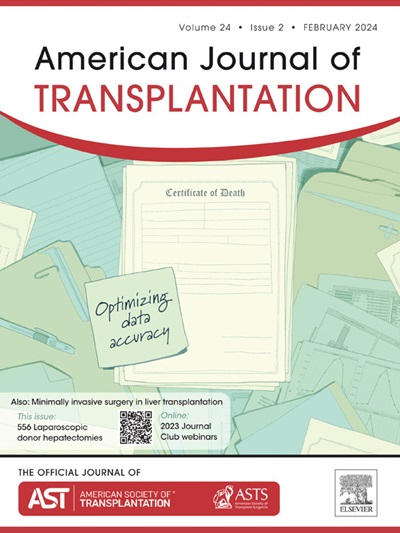依维莫司联合治疗与肝移植后癌症风险的关系:一项全国性的准队列研究。
IF 8.9
2区 医学
Q1 SURGERY
引用次数: 0
摘要
依维莫司在减少肝移植后受者肝细胞癌(HCC)方面的潜力已被报道。这项基于全国人群的准队列研究调查了依维莫司联合钙调磷酸酶抑制剂治疗是否影响HCC和肝外癌的风险,与未接受依维莫司的时间匹配队列相比。使用覆盖韩国整个人口的数据,收集了2015年6月至2020年2月期间开始使用免疫抑制剂的肝移植受者,并将其分为两组:依维莫司联合组和非联合组。我们使用Cox回归模型计算了依维莫司联合治疗HCC和肝外癌风险的校正风险比(aHRs)和绝对风险降低(ARR)。确定了两组932名接受者的时间匹配回顾性队列。依维莫司联合用药组发生HCC的风险较低(aHR, 0.53;95%可信区间[CI] 0.30-0.94)和肝外癌(aHR, 0.30;95% CI 0.14-0.63)与非联合组比较。HCC的ARR为0.004,肝外癌为0.012。研究结果表明,在钙调磷酸酶抑制剂治疗中加入依维莫司可降低肝移植受者的癌症风险,强调在选择免疫抑制疗法时考虑癌症风险的重要性。本文章由计算机程序翻译,如有差异,请以英文原文为准。
Association between Everolimus Combination Therapy and Cancer Risk after Liver Transplantation: A Nationwide Population-based Quasi-Cohort Study.
The potential of everolimus in reducing hepatocellular carcinoma (HCC) among recipients following liver transplantation has been reported. This nationwide population-based quasi-cohort study investigated whether combining everolimus with calcineurin inhibitor therapy affects the risk of HCC and extrahepatic cancers compared to a time-duration-matched cohort of recipients not receiving everolimus. Using data covering the entire population from Korea, liver transplant recipients who had initiated immunosuppressants between June 2015 and February 2020 were collected and divided into two groups: the everolimus combination and non-combination groups. We calculated adjusted hazard ratios (aHRs) and absolute risk reduction (ARR) for the risk of HCC and extrahepatic cancer with everolimus combination therapy using a Cox regression model. A time-duration-matched retrospective cohort of 932 recipients in both of the groups was identified. The everolimus combination group showed a lower risk of HCC (aHR, 0.53; 95% confidence interval [CI] 0.30-0.94) and extrahepatic cancers (aHR, 0.30; 95% CI 0.14-0.63) compared to the non-combination group. The ARR was 0.004 for HCC and 0.012 for extrahepatic cancer. The findings suggest that adding everolimus to calcineurin inhibitor therapy reduces cancer risk in liver transplant recipients, highlighting the importance of considering cancer risk when choosing immunosuppressive therapies.
求助全文
通过发布文献求助,成功后即可免费获取论文全文。
去求助
来源期刊
CiteScore
18.70
自引率
4.50%
发文量
346
审稿时长
26 days
期刊介绍:
The American Journal of Transplantation is a leading journal in the field of transplantation. It serves as a forum for debate and reassessment, an agent of change, and a major platform for promoting understanding, improving results, and advancing science. Published monthly, it provides an essential resource for researchers and clinicians worldwide.
The journal publishes original articles, case reports, invited reviews, letters to the editor, critical reviews, news features, consensus documents, and guidelines over 12 issues a year. It covers all major subject areas in transplantation, including thoracic (heart, lung), abdominal (kidney, liver, pancreas, islets), tissue and stem cell transplantation, organ and tissue donation and preservation, tissue injury, repair, inflammation, and aging, histocompatibility, drugs and pharmacology, graft survival, and prevention of graft dysfunction and failure. It also explores ethical and social issues in the field.

 求助内容:
求助内容: 应助结果提醒方式:
应助结果提醒方式:


